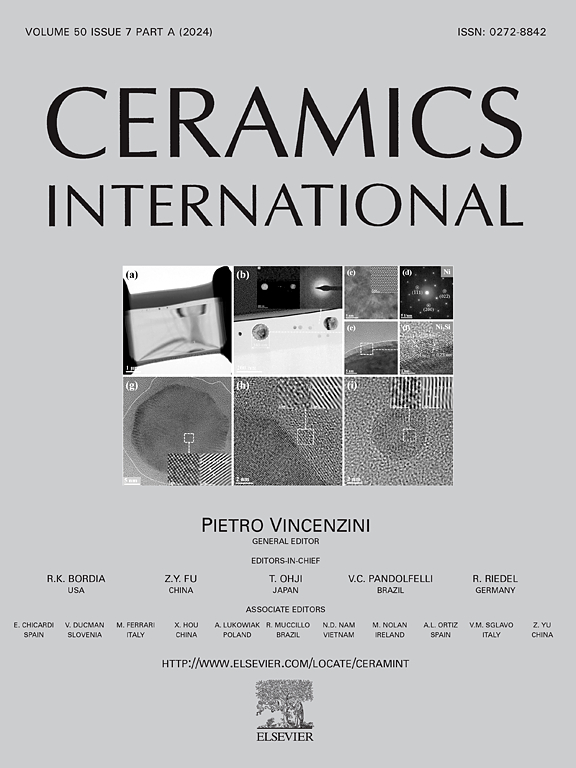轻质C/SiO2-ZrO2复合材料的制备及其烧蚀性能
IF 5.6
2区 材料科学
Q1 MATERIALS SCIENCE, CERAMICS
引用次数: 0
摘要
轻量化和热防护是提高高超声速飞行器性能的关键。因此,在抗烧蚀性和轻量化之间找到平衡已成为当务之急。本文采用溶胶-凝胶和真空烧结法制备了轻质C/SiO2-ZrO2复合材料。对不同溶胶浸渍碳纤维的微观形貌进行了表征和探讨。研究了SiO2/ZrO2涂层和SiO2-ZrO2杂化涂层对样品抗烧蚀性能的影响。结果表明:与SiO2/ZrO2涂层相比,杂化SiO2-ZrO2涂层与碳纤维的结合更加紧密;此外,C/SiO2-ZrO2具有低密度(0.347 g/cm3)和最佳抗烧蚀性能。1.6 MW/m2烧蚀120 s后,线/质量烧蚀速率分别为0.71 μm/s和2.09 mg/s。抗烧蚀性能的增强主要是由于与ZrSiO4形成了SiO2-ZrO2共晶体系,保证了涂层在烧蚀过程中的完整性,有效地阻止了氧气侵入碳纤维。这些样品展示了轻质耐烧蚀材料领域的潜在应用。本文章由计算机程序翻译,如有差异,请以英文原文为准。
Preparation and ablation behavior of lightweight C/SiO2-ZrO2 composites
Lightweight and thermal protection are crucial for improving the performance of hypersonic vehicles. Thus, it has become imperative to find a balance between ablation resistance and lightweight. Here, lightweight C/SiO2-ZrO2 composites were prepared by sol-gel and vacuum sintering method. The microscopic morphology of different sol-impregnated carbon fibers was characterized and explored. Effects of SiO2/ZrO2 coatings and hybrid SiO2-ZrO2 coatings on the ablation resistance of the samples were investigated. The results showed that hybrid SiO2-ZrO2 coatings are more tightly bonded to the carbon fibers than SiO2/ZrO2 coatings. Additionally, C/SiO2-ZrO2 demonstrated low density (0.347 g/cm3) and optimal ablation resistance. Following ablation at 1.6 MW/m2 for 120 s, the line/mass ablation rates were 0.71 μm/s and 2.09 mg/s, respectively. The enhanced ablation resistance is mainly attributed to the formation of the SiO2-ZrO2 eutectic system with ZrSiO4, which ensures the integrity of the coating during the ablation process and effectively prevents oxygen from intruding into the carbon fiber. These samples demonstrate potential applications in the field of lightweight ablation-resistant materials.
求助全文
通过发布文献求助,成功后即可免费获取论文全文。
去求助
来源期刊

Ceramics International
工程技术-材料科学:硅酸盐
CiteScore
9.40
自引率
15.40%
发文量
4558
审稿时长
25 days
期刊介绍:
Ceramics International covers the science of advanced ceramic materials. The journal encourages contributions that demonstrate how an understanding of the basic chemical and physical phenomena may direct materials design and stimulate ideas for new or improved processing techniques, in order to obtain materials with desired structural features and properties.
Ceramics International covers oxide and non-oxide ceramics, functional glasses, glass ceramics, amorphous inorganic non-metallic materials (and their combinations with metal and organic materials), in the form of particulates, dense or porous bodies, thin/thick films and laminated, graded and composite structures. Process related topics such as ceramic-ceramic joints or joining ceramics with dissimilar materials, as well as surface finishing and conditioning are also covered. Besides traditional processing techniques, manufacturing routes of interest include innovative procedures benefiting from externally applied stresses, electromagnetic fields and energetic beams, as well as top-down and self-assembly nanotechnology approaches. In addition, the journal welcomes submissions on bio-inspired and bio-enabled materials designs, experimentally validated multi scale modelling and simulation for materials design, and the use of the most advanced chemical and physical characterization techniques of structure, properties and behaviour.
Technologically relevant low-dimensional systems are a particular focus of Ceramics International. These include 0, 1 and 2-D nanomaterials (also covering CNTs, graphene and related materials, and diamond-like carbons), their nanocomposites, as well as nano-hybrids and hierarchical multifunctional nanostructures that might integrate molecular, biological and electronic components.
 求助内容:
求助内容: 应助结果提醒方式:
应助结果提醒方式:


